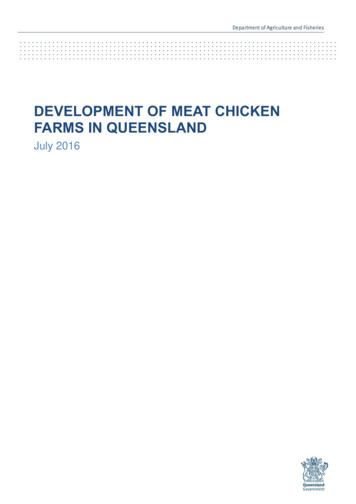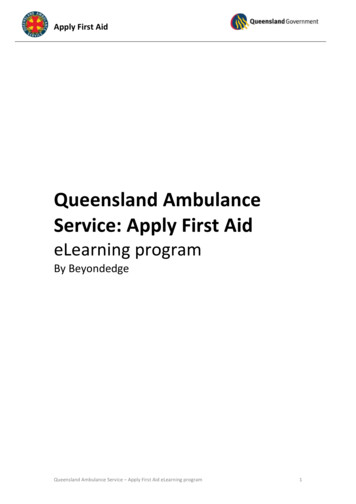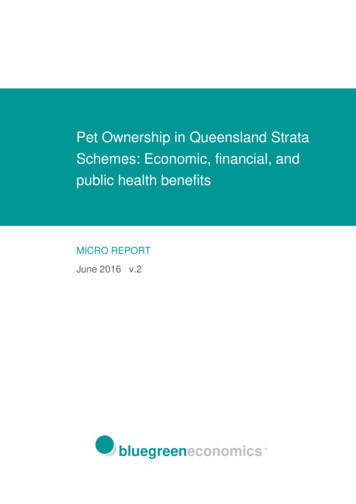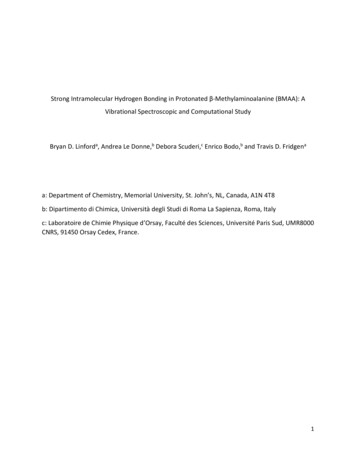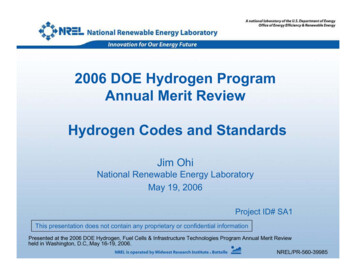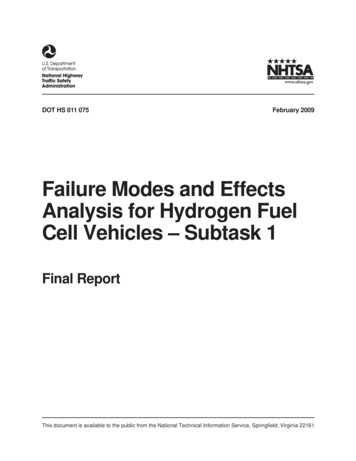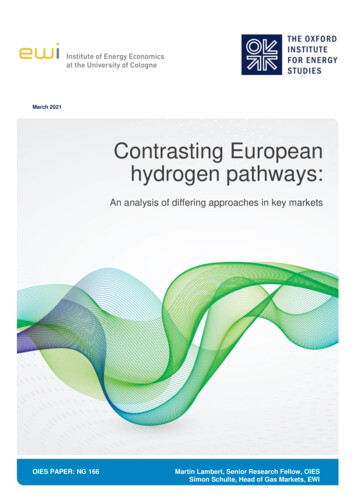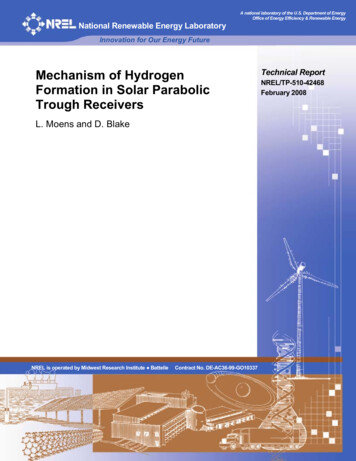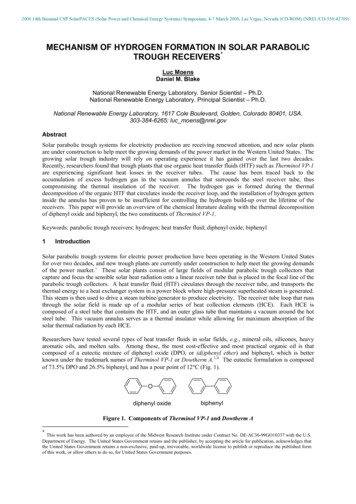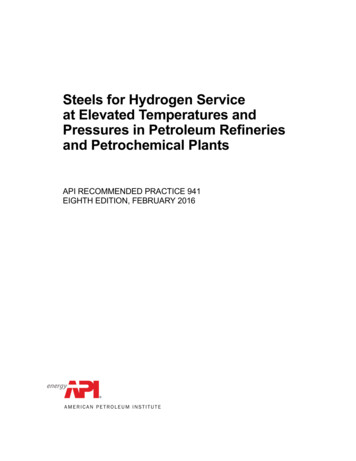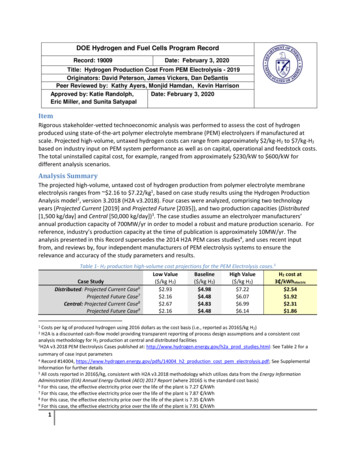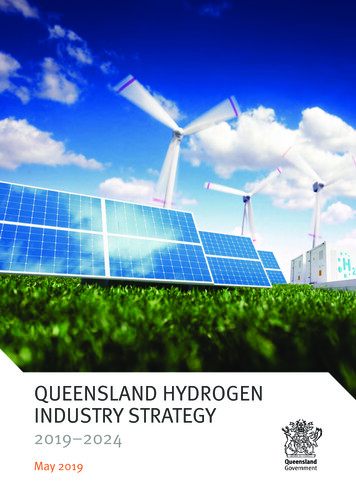
Transcription
QUEENSLAND HYDROGENINDUSTRY STRATEGY2019–2024May 2019
The Department of State Development, Manufacturing, Infrastructure and PlanningCopyrightThis publication is protected by the Copyright Act 1968.LicenceThis work, except as identified below, is licensed by the Department of State Development, Manufacturing,Infrastructure and Planning under a Creative Commons Attribution-Non-Commercial-No Derivative Works(CC BY-NC-ND) 4.0 Australia licence. To view a copy of this licence, visit: http://creativecommons.org.au/You are free to copy, communicate and adapt this publication, as long as you attribute it as follows: State of Queensland, Department of State Development, Manufacturing, Infrastructure and Planning, May 2019.The Queensland Government is committed to providing accessible services to Queenslanders of all cultural andlinguistic backgrounds. If you have difficulty understanding this publication and need a translator, please call theTranslating and Interpreting Service (TIS National) on telephone 131 450 and ask them to contact the QueenslandDepartment of State Development, Manufacturing, Infrastructure and Planning on (07) 3452 7100.DisclaimerWhile every care has been taken in preparing this publication, the State of Queensland accepts no responsibility for decisions oractions taken as a result of any data, information, statement or advice, expressed or implied, contained within. To the best of ourknowledge, the content was correct at the time of publishing.Copies of this publication are available on our website at www.dsdmip.qld.gov.au and further copies are available upon requestto:Department of State Development, Manufacturing, Infrastructure and PlanningPO Box 15009, City East, Queensland 4002Phone:Email:Web:13QGOV (13 74 68)info@dsdmip.qld.gov.auwww.dsdmip.qld.gov.au
Foreword from the PremierHydrogen provides the opportunity to export Queensland’s sunshine to the world and support more jobs inregional Queensland.My Government’s record of attracting investment in renewables combined with our existing gas pipelineinfrastructure and export facilities make us the ideal state to lead the future production and export of hydrogen.We backed the 60 billion LNG industry providing thousands of jobs for our regions.Now the world is looking to hydrogen and we want them to get it from Queensland so we can create even morejobs in our regions.This emerging industry will have enormous economic benefits for Australia, worth an estimated 1.7 billion inexports annually by 2030.Now is the time for Queensland to position itself as a significant hydrogen trading partner with ourinternational neighbours.I have met with Government officials and major companies in Japan and South Korea to discuss the potential forQueensland to export ‘green hydrogen’ produced using renewable energy sources. Both countries have ambitiousplans for renewable hydrogen to meet their domestic energy needs, and Queensland is well-placed to support theenergy goals of these long-standing trading partners.Earlier this year, we celebrated our State’s first delivery of green hydrogen to Japan, exported by the Japanesepetroleum conglomerate JXTG. This was produced at the Queensland University of Technology’s solar cell facilityat the Queensland Government’s Redlands Research Facility.Queensland’s and Australia’s growing populations and economies also require increasing supplies of reliable,affordable and preferably renewable power. Manufacturing sectors that use hydrogen in their processes will alsobenefit from a reliable domestic supply.My government’s priorities are creating jobs in a strong economy and supporting the development of this industrystrongly aligns with that.The 19 million committed to this strategy will give Queensland the best start possible to succeed in becoming ahydrogen exporter of choice for the world.The Honourable Annastacia Palaszczuk MPPremier of Queensland and Minister for Trade
Hyundai NEXO fuel cell. Image courtesy of Hyundai.
Foreword from the MinisterCreating jobs of the future while propelling and diversifying our economy remains a key focus of our government.That’s why we’re committed to growing Queensland’s hydrogen industry as it holds significant potential for ourstate: for employment, investment and overseas export.The development of a domestic hydrogen industry, including the production of competitively priced renewablehydrogen, will have widespread economic benefits.Hydrogen is a versatile energy carrier with a diverse range of applications, including energy supply and transportand industrial applications like biorefineries.Gladstone, one of Queensland’s industrial powerhouses, will be a focus point for hydrogen development, and forgood reason.Existing industries, gas infrastructure, access to a deep-water export port and skilled local workers make it anattractive location for this emerging industry.Gladstone also has a strategically placed State Development Area, that through the powers of the CoordinatorGeneral, gives our government the ability to facilitate large-scale industrial development.Working in partnership with local researchers and international partners, and leveraging advanced manufacturingtechnologies, systems, products and services, Queensland is primed to develop a safe and sustainable hydrogenindustry that has the potential to generate wealth, jobs and economic growth for our state.The Honourable Cameron Dick MPMinister for State Development,Manufacturing, Infrastructure and Planning
ContentsAbout the strategy. 1Vision. 2The global hydrogen agenda. 4–5Hydrogen's role in our clean energy future. 6Queensland's hydrogen industry. 8Queesland's competitive position. 10Probusiness investment environment. 10Proximity to key export markets andestablished trading partners.11Renewable resources.11Skilled workforce and world-class educationand research facilities. 12Focus areas.13Supporting innovation.15Facilitating private sector investment. 19Ensuring an effective policy frameworkfor sustainable development. 21Building community awareness and confidence. 23Facilitating skills development for new technology. 25Queensland Hydrogen Industry Strategy actions. 26–27Implementation and review. 28References. 29Image courtesy of Toyota.
About the strategyA Queensland hydrogen industry hasthe potential to deliver significanteconomic, employment, energysecurity and environmental benefitsfor Queensland and Australia.The Queensland Government is committed to developing a sustainable hydrogen industry.Queensland has a unique competitive advantage in the production of renewable hydrogen. With its close proximityto Asia, established infrastructure, manufacturing capabilities and renewable energy potential, Queensland iswell-positioned to benefit from the global transition to a low-emission energy future.In September 2018, the Advancing Queensland’s hydrogen industry discussion paper was released by the QueenslandGovernmenti. Thirty-three submissions were received from a broad range of stakeholders, identifying opportunities for,and the challenges faced by the hydrogen industry. The feedback, along with an extensive program of meetings withindustry and researchers, has shaped the development of the Queensland Hydrogen Industry Strategy 2019–2024 (thestrategy). The strategy is underpinned by comprehensive research on national and international trends and best practiceapproaches adopted in jurisdictions with growing renewable hydrogen industries.The objective of the strategy is to drive the development of an economically sustainable and competitive hydrogenindustry that creates economic growth, opportunities for new export markets, generates the highly skilled jobs of thefuture, while supporting the transition to a low-emission economy. The strategy will ensure that government and industrywork towards a common vision for Queensland’s future hydrogen industry, with specific actions in five focus areas.Implementation of this strategy will help us take advantage of the many opportunities for domestic energy uses,new export markets and skilled jobs from hydrogen, while also benefiting from cleaner energy generation and lowercarbon emissions.Success will be seen through a demonstration of industry confidence, measured by strong investment in the hydrogenindustry, growing production of cost-competitive renewable hydrogen and the creation of new high-tech jobs acrossthe industry.Growing a sustainable hydrogen industry is consistent with the Queensland Government objectives for the communityii.Page 1
VisionBy 2030, Queensland is at the forefront ofrenewable hydrogen production in Australia,supplying an established domestic marketand export partners with a safe, sustainableand reliable supply of hydrogen.What is renewable hydrogen?Renewable hydrogen is produced without the use of fossil fuels. Most commonly, renewable energy such assolar or wind is used to generate carbon-neutral (and sometimes carbon-negative) hydrogen or hydrogenderivatives. Hydrogen (or biofuels) can also be produced from residual biomass of other waste streams suchas municipal solid waste. When used within a fuel cell, hydrogen is part of a catalytic process that generateselectricity without combustion, eliminating greenhouse gases (GHGs) and air pollutants.With so many ways to produce hydrogen, it is common to differentiate between renewable hydrogen andother sources.Hydrogen produced from water electrolysis and renewable energy is known as green hydrogen. This termhas been used to distinguish between carbon-neutral hydrogen and hydrogen produced from fossil fuels,which is known as brown hydrogen. Approximately 95 per cent of global production is brown hydrogen thatis manufactured by steam methane reformation, where high-temperature steam (700 C–1,000 C) is used toproduce hydrogen from a methane source, such as natural gas.Blue hydrogen is produced by incorporating carbon capture and storage into the steam methane reformationproduction processes. Blue hydrogen is seen as a step towards achieving carbon-free energy.Options for a hydrogen-based fuels green certification system for Australia are currently being investigatedby the Commonwealth Scientific and Industrial Research Organisation (CSIRO) through Hydrogen MobilityAustralia. The Queensland Government views a national accreditation system that is recognised in key exportmarkets as important for the development of the hydrogen industry.Page 2 Queensland Hydrogen Industry Strategy 2019–2024
The race to a global hydrogen economyThe appetite to explore hydrogen as an energy carrier is growing at pace, with billions of dollars beingspent worldwide on pioneering projects to integrate hydrogen into energy markets.Conditions are favourable in Queensland to capitalise on domestic technological breakthroughs andthe global momentum to grow the hydrogen economy. In August 2018, the CSIRO demonstrated theirworld-first technology for refueling fuel cell electric vehicles (FCEV’s) from ammonia at the QueenslandCentre for Advanced Technologies. This project was supported by Hydrogen Mobility Australia members(including BOC, Hyundai and Toyota). The unique membrane technology enables the production ofultra-high purity hydrogen from ammonia. The membrane technology breakthrough has the potential toallow hydrogen (as ammonia) to be safely transported and used as a mass-production energy carrier.South Korea, Japan, the United States and Europe have all made significant commitments to establishingsuccessful hydrogen industries and have implemented programs to support the rapid scaling up ofhydrogen production and use.Some exciting recent hydrogen developments include: Germany has rolled out the world’s first hydrogen-powered trains, which were put into service inthe Lower Saxony region in September 2018. The two hydrogen trains can run for about 600 miles(1000 km) on a single tank of hydrogen, similar to the range of diesel trains. Norway has commissioned HYON AS, a Norwegian group to design and build two hydrogen-fueledvessels, a zero-emission passenger ferry and short trip cargo ship. New Brunswick Power recently announced it is building the world’s first hydrogen-powereddistributed electricity grid, using readily available seawater. The system will include multipledistributed stations incorporating renewable energy to provide net zero emission base load power.New Brunswick Power is the primary electric utility in New Brunswick, Canada and was establishedin 1920. The 7-Eleven chain in Japan has announced it is partnering with Toyota to introducehydrogen-fueled refrigerated delivery trucks for its distribution process. The trucks will beoperational in 2019. The 7-Eleven company has almost 20,000 stores across Japan, including morethan 2500 in Tokyo alone.Image courtesy of Toyota.Page 3
The global hydrogen agendaThe potential for hydrogen as an energy carrier and fuel has been recognised for decades. In the past few years this interest has escalated, resulting from three key drivers:decarbonisation, emerging export markets and falling renewable electricity costs. The image below highlights some recent hydrogen policies or policy positions both in Australia andglobally. This list is not exhaustive, and does not take into account general emissions reduction or renewable energy policies.12 2016 UK2017 UKClean Growth Strategy identifies100 per cent conversion of the gasdistribution network to hydrogen asa credible decarbonisation option.3 2018 CHINA4 2017 JAPANChina announces ‘hydrogencity’ to be developed by 2025.United Kingdom publishesHydrogen and Fuel Cells:Opportunities for Growth –A roadmap for the UK.Japan develops hydrogen strategymapping out goals for hydrogenproduction and consumption for2020, 2030 and beyond (with2019 update).Japan aims to showcase hydrogenas a clean fuel alternative at the2020 Olympic games.12 2019 EUROPEIn January 2019 the Fuel Cellsand Hydrogen JointUndertaking released theHydrogen Roadmap Europe:A sustainable pathway for theEuropean energy transition.5 2017 AUSTRALIA2South Australia launchesHydrogen Roadmap.CSIRO launches new FutureScience Platform forhydrogen energy systems.131211 2013 CALIFORNIA (USA)California’s state law AB8provides funding for 100hydrogen refuelling stations.1181046 2018 AUSTRALIA9Hydrogen Mobility Australiaestablished.‘Hydrogen month’ sees the releaseof three significant reports:710 2017 INTERNATIONAL5The Hydrogen Council launches – ‘aglobal initiative of leading energy,transport and industry companieswith a united vision and long-termambition for hydrogen to foster theenergy transition.’67 2019 SINGAPORE9 2016 TAIWANTaiwan Government lists hydrogenas one of its focuses in its greenenergy development plan.Page 4 Queensland Hydrogen Industry Strategy 2019–20248 2019 SOUTH KOREAThe South Korean Governmentreleases the Hydrogen EconomyRoadmap of Korea.Singapore Government issues atender calling for a consultancy studyon how the country could harnesshydrogen as a sustainable source ofenergy.National Hydrogen Roadmap(CSIRO)Hydrogen for Australia’s Future(Hydrogen Strategy Group forthe Council of AustralianGovernments (COAG) EnergyCouncil)Opportunities for Australia fromHydrogen Exports (ACIL AllenConsulting for ARENA).Hydrogen Mobility Australiapartners with Standards Australiafor adoption of hydrogenstandards.COAG Energy Council approves aproposal for a national hydrogenstrategy.Queensland releases hydrogenindustry discussion paper.Page 5
Hydrogen’s role in our clean energy futureA versatile energy carrierAlmost anything that uses energy can be powered by hydrogen. Hydrogen produced from biomass, or made usingrenewable energy sources, is a clean and flexible energy carrier that can help reduce carbon emissions from transport,power generation and industrial sectors.Power from renewable energy sources, such as wind or solar, is used to power an electrolyser which generates hydrogenby splitting water into hydrogen and oxygen. While historically more expensive, this process has no carbon emissions.Rapid improvements in cost and performance of renewable hydrogen technologies has occurred and is projectedto continue.The co-location of hydrogen production facilities with waste water treatment plants is an emerging opportunity that willincrease efficiencies for both operations. Waste water can be used as an input to the hydrogen production process, withthe by-product oxygen supplied back to the treatment plant for optimal processing efficiency.H2Hydrogen storageRenewable energyElectrolysisElectricityIndustryTransportA response to emissions targetsThe Queensland Government has set a state target to reach zero net emissions by 2050, with an interim target of a30 per cent reduction in emissions by 2030. Renewable hydrogen has the potential to play a significant role in achievingthese targets and will reinforce Queensland’s position at the forefront of global climate actioniii.The Queensland Climate Transition Strategy will guide policy and drive the investment needed to put Queensland on thepath to a zero net emissions economyiv. Programs such as Solar 150 are supporting a solar investment boom throughlong-term revenue certainty for proponentsv.A grid stabiliserAs renewable generation capacity increases, attention is being focused on how surplus electricity generated byrenewables can be captured for later use or to provide a source of dispatchable power. Balancing supply and demandacross the electricity grid will require new solutions if energy systems are to fully decarbonise while maintaining currentlevels of cost and reliability. Hydrogen technologies can assist with both the integration and expansion of low-carbonelectricity generation by providing grid stabilisation and demand management mechanisms.When excess electricity is produced from renewable resources, such as solar, the electricity can be stored as hydrogenrather than feeding it back into the grid. Once stored, hydrogen energy can be produced with very little initialisation time,making it possible to store renewable energy until demand increases. The ability to manage grid demand will smooth outpressure currently placed on the grid during times of peak use.Page 6 Queensland Hydrogen Industry Strategy 2019–2024
A supplement for natural gasHydrogen can also be used to supplement the current domestic gas supply. The Hydrogen Strategy Group COAG briefingpaper Hydrogen for Australia’s future states: 'Hydrogen can be safely added to natural gas supplies at 10per cent byvolume without changes to pipelines, appliances or regulations.' A detailed study has been commissioned as part of thedevelopment of the national hydrogen strategy to review any barriers to hydrogen injection in gas distribution networksfrom a regulatory, technical or legal viewpoint in each state. With further research and testing, there is potential to increasethe concentration of hydrogen in the gas supply.Energy Networks Australia, the premier national body representing Australia’s gas distribution and electricity transmissionand distribution companies, identified hydrogen innovation and
energy goals of these long-standing trading partners. Earlier this year, we celebrated our State’s first delivery of green hydrogen to Japan, exported by the Japanese petroleum conglomerate JXTG. This was produced at the Queensland University of Technology’s solar cell facility a
